Model Of Supervision Assignment
- Country :
Australia
TOPIC 2: A Model for Supervision
Objectives
At the completion of this topic you should be able to:
- reflect on the context in which supervision is provided and the ways in which this may influence the supervision process;
- identify and articulate the key components of clinical supervision;
- understand how you might negotiate arrangements for supervision or a supervision contract; and
- identify the ways in which critical and reflective practice relate to clinical supervision.
Completion of this topic will assist in you meeting the unit objectives that relate to identification of the key components of clinical supervision and development of a supervision contract. This topic will also contribute to achievement of the Unit objective concerned with a critical evaluation of your own supervisory style.
Contents:
- Introduction
- What do we mean by clinical supervision?
- A framework for supervision
- Negotiating a supervision contract
- Conclusion
- References
Introduction
As suggested by Objective 1 for this topic, supervision does not occur within a vacuum. It occurs within a context of overriding policy, organization and the values and skills that the profession holds as important. As well, it is an interactional process that occurs between two unique individuals, the supervisor and the supervisee. What is important is to reflect on the context which can be conceptualized as continuous interactions between the macro, mezzo and micro influences on supervision. We will consider these various levels of context later in this unit.
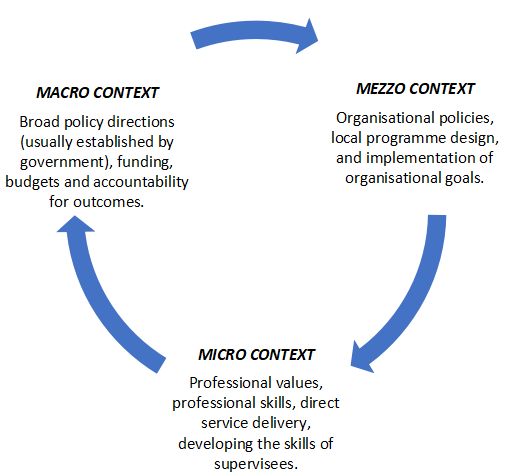
Figure 3.1: The context for supervision
Figure 3.1 seeks to highlight the ways in which all three contextual levels influence the delivery of supervision. What is important is that these are specifically acknowledged in the supervision process but are not allowed to diminish the focus on the supervision relationship.
Activity: Reflections on context
In order to achieve Objective 1 of this topic, you are invited to identify some of the levels of contextual influence that have impact on your delivery of supervision. What are some of these? How do they shape your supervision? What are some of the opportunities available in your context and what might be some of the limitations?
What do we mean by clinical supervision
It is important to pause and take some time to seek an understanding of supervision as it can mean different things to different people and different professions. In seeking to define clinical supervision, we are working around Objective 2 for this topic.
Many years ago I was involved in supervising a social work student. I met with this student on the second day of placement for supervision. At the end of the discussion I suggested we needed to make a time for the future supervision session. The student looked somewhat surprised; he explained that his experience of supervision (in a non social service profession) was that supervision was offered only when there is a problem with performance!
In some ways my student was right in his thinking. Supervision does literally mean overseeing and is concerned with making sure that the supervisee acts correctly. However, a more useful definition links supervision to a broader concept of:
a relationship-based activity which enables practitioners to reflect upon the connection between task and process within their work. It provides a supportive, administrative and developmental context within which responsiveness to clients and accountable decision making can be sustained (Davies 2000 cited in Irwin 2011 p 44).
What is important about this definition is that it embraces a vision of supervision that moves well beyond the overseeing role and becomes concerned with the breadth and depth of service delivery. It is a definition that allows for the teaching of technical skills such as how to fill out the client case notes/ statistics on the agency data base, complete a risk assessment or develop an exercise regime for rehabilitation, as well as for understanding the wider context in which these technical skills are delivered. It is also a definition that is consistent with conceptualizing the provision of supervision as becoming a professional developer for the staff that you supervise.
It is seeing your supervisees' develop their clinical skills as well as their critical and reflective competencies that best illustrates the effectiveness of your supervision. Without engendering a critical and reflective approach to practice, the risk is that supervisees will develop technical competencies at the cost of development of the intuitive, interactional approaches that are central to working in direct service delivery.
The other important aspect of this definition is that it emphasizes supervision as a relationship-based activity. What this suggests is that it is equally important to reflect on, and commit time to, the development of the supervisory relationship. The imparting of technical knowledge and skills is not the only thing that supervisees want. According to Gibb, Anderson and Forsyth (2004) qualities that supervisees seek from/in their supervisor include:
- approachability;
- extent of knowledge;
- clinical skill level;
- presenting a non-intimidating persona;
- understanding role limitations; and
- ability to demonstrate leading practice.
To achieve these requirements, in the absence of an established relationship, would indeed be difficult. Arguably, the relationship acts as the medium through which the supervision and teaching tasks are implemented. The quality of the relationship and the level of transparency, that you develop with the supervisee will directly relate to the development of the skills of the supervisee. If you are open, non-judgemental, approachable and interested, the supervisee is more likely to seek, and accept, your input into their development.
Your supervision style
Take a moment to reflect on the findings concerning what supervisees want from supervision. What do you see as your strengths and what are the areas, as a supervisor, that you need to work on? Participation in this exercise should assist you to focus on the assessment tasks of this unit as well as contributing to the development of your portfolio for supervision.
Table 3.1: Your supervision style
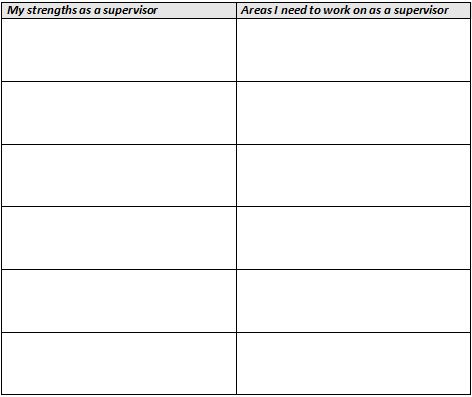
A framework for supervision
The basic framework for supervision, developed by Alfred Kadushin (1976), suggested that there are three primary functions of supervision. These are administrative, educative and supportive functions. Since that time there have been further developments in the model(s) of supervision, other researchers taking slightly different approaches, a notable additional function concerning mediation. However, in all models of supervision it would appear that there are agreements about the primary tasks that the supervisor fulfils. Consideration of this framework is related to the achievement of the Objective 2 for this Topic.
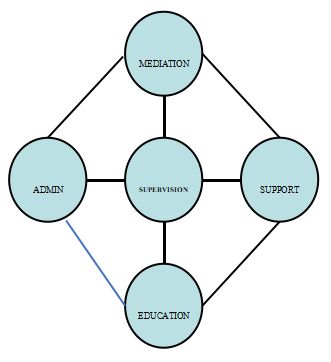
Figure 3.2: A framework for supervision
The intent of this approach is to demonstrate that supervision is a complex process made up of interlocking components. While supervisors do not fulfil all of the components all of the time, they will undertake each of the components most of the time. While each of the functions, to at least some extent, overlaps with the other functions, there are core activities associated with each of these. See Table 3.2.
Table 3.2: The functions of supervision
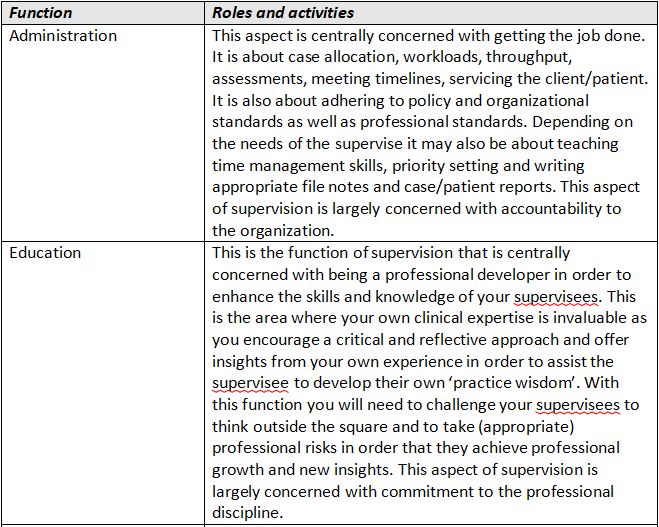
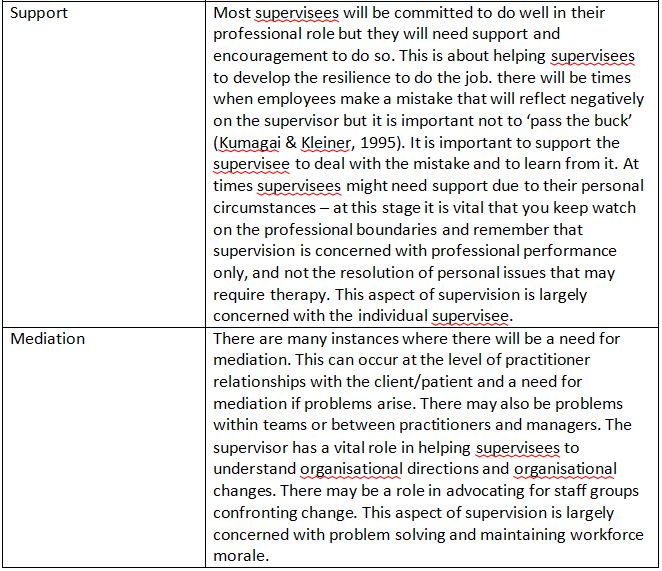
Negotiating a supervision contract
Objective 3 for this topic, concerns the development of a supervision contract.
I would argue that all supervision relationships need to be governed by a contract that is negotiated between the supervisor and supervisee. I would also argue that this should be documented and that it should also be a contract that evolves over time and is reviewed at least on an annual basis in order that it is adjusted to reflect achievements gained and changing needs as supervisees develop their professional skill. However, it is clear that, documentation of all aspects of supervision, including the supervision contract, will be central to resolving performance concerns.
I would also argue that length and breadth of experience does not diminish the need for supervision. All professionals need to commit to life-long learning and to the achievement of best practice. Supervision is centrally concerned with these values and the need to engage in reflection does not diminish over time, nor does the need for support in our professional lives.
Where the length of experience does influence supervision is in the area of the content of supervision. Generally, less experienced practitioners need more frequent supervision that has greater emphasis on the teaching of clinical skills and procedural matters. More experienced practitioners are better equipped to engage in reflective professional debate.
Before becoming involved in the negotiation of the supervision contract, it is important to reflect on what you expect your supervisees to achieve, how you supervise and what input you will offer.
Some matters that must be considered are detailed in Table 3.3.
Table 3.3: Considerations for the supervision contract
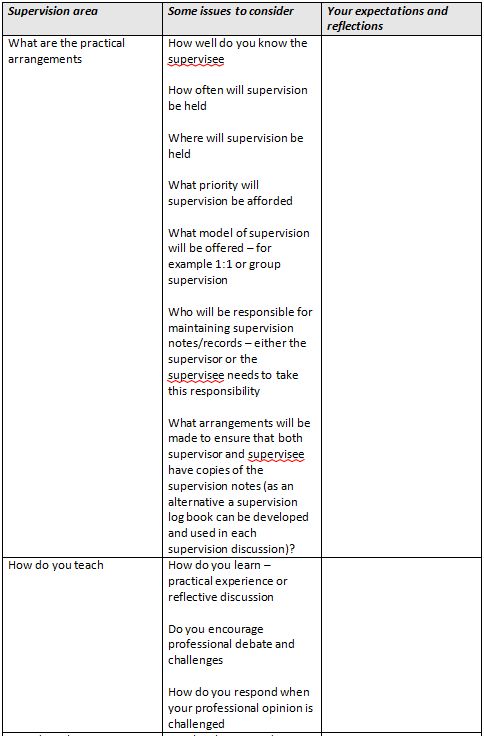
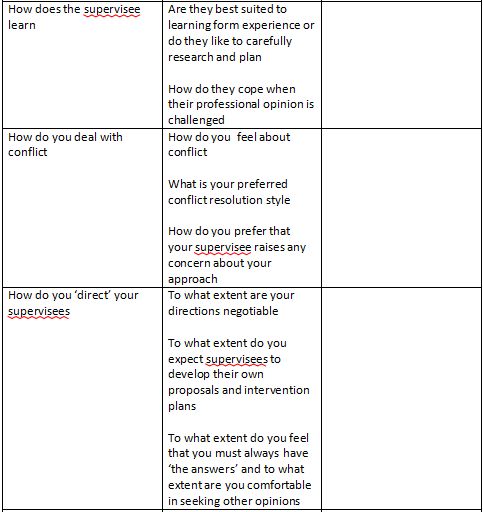
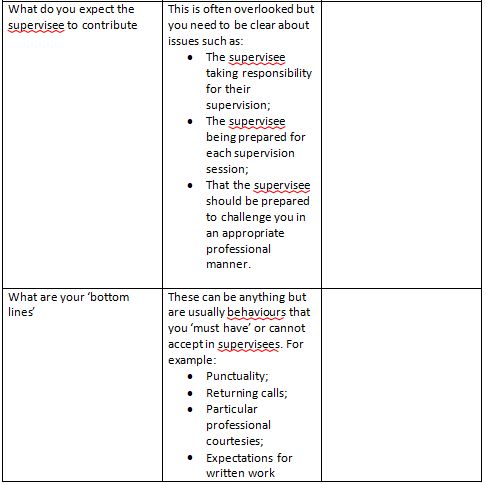
These are crucial issues that must be discussed and agreed in advance of setting out the actual goals and objectives of supervision. They are issues that shape the nature of the relationship you will have with your supervisee and failure to openly discuss and resolve these matters, in advance of the establishing the agreed areas for supervision, risks undermining the process.
Of course these are not issues that can be quickly resolved, especially with new supervisees. They require that there is dialogue over a few sessions and that this dialogue involves both supervisor and supervisee responding to these issues. The discussion should also enable mutual adjustments to be made where styles do not directly match each other. It is important here to emphasise the notion of mutual adjustment. It is not only the supervisee that needs to adapt to the supervisor but also the supervisor needs to be sufficiently flexible to offer supervision and professional development to a wide range of supervisees.
Are you struggling to keep up with the demands of your academic journey? Don't worry, we've got your back! Exam Question Bank is your trusted partner in achieving academic excellence for all kind of technical and non-technical subjects.
Our comprehensive range of academic services is designed to cater to students at every level. Whether you're a high school student, a college undergraduate, or pursuing advanced studies, we have the expertise and resources to support you.
To connect with expert and ask your query click here Exam Question Bank

